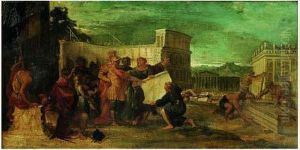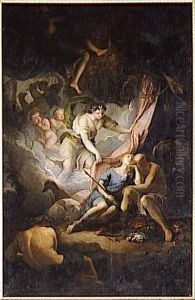Gabriel Blanchard Paintings
Gabriel Blanchard was a French painter, born in 1630 in Paris, France. He was known for his work in the Baroque style, which was prominent in European art from the early 17th century until the 1740s. Blanchard's contributions to art were primarily in the realms of history painting, religious subjects, and portraits, reflecting the grandeur and dramatic intensity characteristic of the Baroque movement.
Blanchard received his early training from his father, Jacques Blanchard, who was also a painter, albeit less well-known. This early exposure to art and his father's workshop provided him with a solid foundation in the techniques and themes that were popular in French art at the time. Later, he became a student of Charles Le Brun, the leading French artist of the period and the principal painter to King Louis XIV. Under Le Brun's guidance, Blanchard's style further developed, incorporating the opulent and dynamic elements that defined the French Baroque.
Throughout his career, Gabriel Blanchard took on various prestigious commissions that solidified his reputation within the French art scene. His works were celebrated for their vivid expression, refined color palette, and the ability to convey deep emotional and spiritual messages through religious and mythological themes. Despite his success, details about his personal life and the exact number of works he produced remain relatively obscure, as is common with many artists of his time.
Blanchard's contributions to French art were not limited to his paintings. He was also involved in the decoration of several important buildings in Paris and its surroundings, showcasing his versatility as an artist. His ability to work on large-scale projects and smaller, more intimate pieces allowed him to leave a lasting imprint on the French artistic landscape.
The artist passed away in 1704, leaving behind a legacy that, while not as widely recognized as some of his contemporaries, significantly impacted the development of French art. Gabriel Blanchard's work continues to be studied and admired for its embodiment of Baroque aesthetics and its intricate depiction of human emotion and divine beauty.

